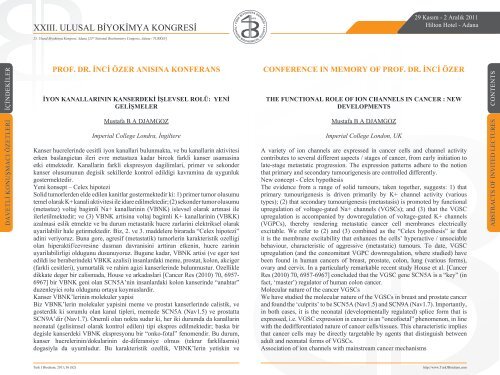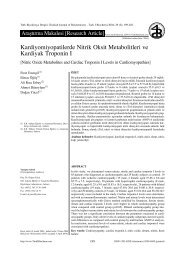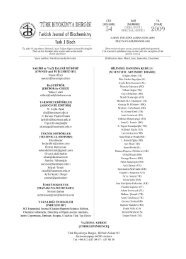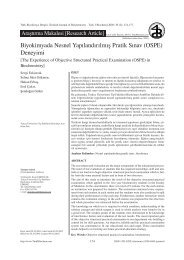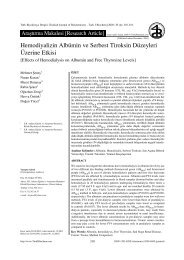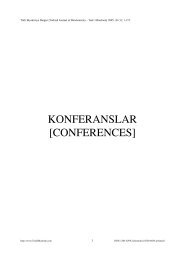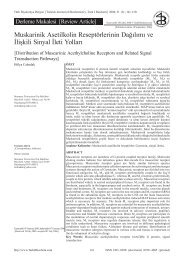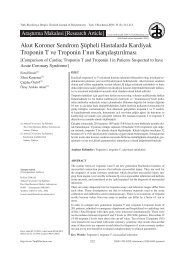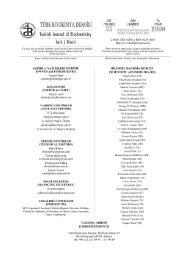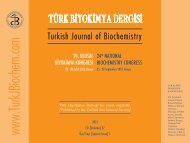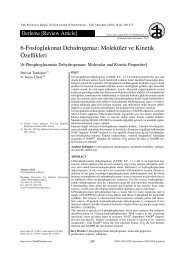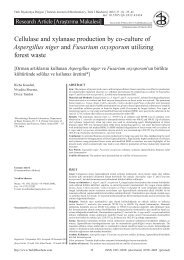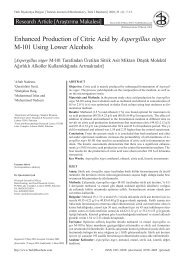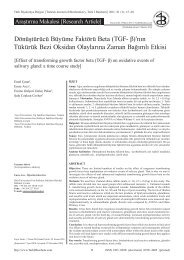23. Ulusal Biyokimya Kongresi Ãzel Sayısı - Türk Biyokimya Dergisi
23. Ulusal Biyokimya Kongresi Ãzel Sayısı - Türk Biyokimya Dergisi
23. Ulusal Biyokimya Kongresi Ãzel Sayısı - Türk Biyokimya Dergisi
Create successful ePaper yourself
Turn your PDF publications into a flip-book with our unique Google optimized e-Paper software.
XXIII. ULUSAL B‹YOK‹MYA KONGRES‹<br />
29 Kasım - 2 Aralık 2011<br />
Hilton Hotel - Adana<br />
<strong>23.</strong> <strong>Ulusal</strong> <strong>Biyokimya</strong> <strong>Kongresi</strong>, Adana [23 rd National Biochemistry Congress, Adana / TURKEY]<br />
İÇİNDEKİLER<br />
PROF. DR. İNCİ ÖZER ANISINA KONFERANS<br />
İYON KANALLARININ KANSERDEKİ İŞLEVSEL ROLÜ: YENİ<br />
GELİŞMELER<br />
CONFERENCE IN MEMORY OF PROF. DR. İNCİ ÖZER<br />
THE FUNCTIONAL ROLE OF ION CHANNELS IN CANCER : NEW<br />
DEVELOPMENTS<br />
CONTENTS<br />
DAVETLİ KONUŞMACI ÖZETLERİ<br />
Mustafa B A DJAMGOZ<br />
Imperial College Londra, İngiltere<br />
Kanser hucrelerinde cesitli iyon kanallari bulunmakta, ve bu kanallarin aktivitesi<br />
erken baslangictan ileri evre metastaza kadar bircok farkli kanser asamasina<br />
etki etmektedir. Kanallarin farkli ekspresyon dagilimlari, primer ve sekonder<br />
kanser olusumunun degisik sekillerde kontrol edildigi kavramina da uygunluk<br />
gostermektedir.<br />
Yeni konsept – Celex hipotezi<br />
Solid tumorlerden elde edilen kanitlar gostermektedir ki: 1) primer tumor olusumu<br />
temel olarak K+ kanali aktivitesi ile idare edilmektedir; (2) sekonder tumor olusumu<br />
(metastaz) voltaj bagimli Na+ kanallarinin (VBNK) islevsel olarak artmasi ile<br />
ilerletilmektedir; ve (3) VBNK artisina voltaj bagimli K+ kanallarinin (VBKK)<br />
azalmasi eslik etmekte ve bu durum metastatik hucre zarlarini elektriksel olarak<br />
uyarilabilir hale getirmektedir. Biz, 2. ve 3. maddelere birarada “Celex hipotezi”<br />
adini veriyoruz. Buna gore, agresif (metastatik) tumorlerin karakteristik ozelligi<br />
olan hiperaktif/cevresine dusman davranisini arttiran etkenin, hucre zarinin<br />
uyarilabilirligi oldugunu dusunuyoruz. Bugune kadar, VBNK artisi (ve eger test<br />
edildi ise beraberindeki VBKK azalisi) insanlardaki meme, prostat, kolon, akciger<br />
(farkli cesitleri), yumurtalik ve rahim agizi kanserlerinde bulunmustur. Ozellikle<br />
dikkate deger bir calismada, House ve arkadaslari [Cancer Res (2010) 70, 6957-<br />
6967] bir VBNK geni olan SCN5A’nin insanlardaki kolon kanserinde “anahtar”<br />
duzenleyici rolu oldugunu ortaya koymuslardir.<br />
Kanser VBNK’lerinin molekuler yapisi<br />
Biz VBNK’lerin molekuler yapisini meme ve prostat kanserlerinde calistik, ve<br />
gosterdik ki sorumlu olan kanal tipleri, memede SCN5A (Nav1.5) ve prostatta<br />
SCN9A’dir (Nav1.7). Onemli olan nokta sudur ki, her iki durumda da kanallarin<br />
neonatal (gelisimsel olarak kontrol edilen) tipi ekspres edilmektedir; baska bir<br />
degisle kanserdeki VBNK ekspresyonu bir “onko-fotal” fenomendir. Bu durum,<br />
kanser hucrelerinin/dokularinin de-diferansiye olmus (tekrar farklilasmis)<br />
dogasiyla da uyumludur. Bu karakteristik ozellik, VBNK’lerin yetiskin ve<br />
Mustafa B A DJAMGOZ<br />
Imperial College London, UK<br />
A variety of ion channels are expressed in cancer cells and channel activity<br />
contributes to several different aspects / stages of cancer, from early initiation to<br />
late-stage metastatic progression. The expression patterns adhere to the notion<br />
that primary and secondary tumourigenesis are controlled differently.<br />
New concept - Celex hypothesis<br />
The evidence from a range of solid tumours, taken together, suggests: 1) that<br />
primary tumourigenesis is driven primarily by K+ channel activity (various<br />
types); (2) that secondary tumourigenesis (metastasis) is promoted by functional<br />
upregulation of voltage-gated Na+ channels (VGSCs); and (3) that the VGSC<br />
upregulation is accompanied by downregulation of voltage-gated K+ channels<br />
(VGPCs), thereby rendering metastatic cancer cell membranes electrically<br />
excitable. We refer to (2) and (3) combined as the “Celex hypothesis” ie that<br />
it is the membrane excitability that enhances the cells’ hyperactive / unsociable<br />
behaviour, characteristic of aggressive (metastatic) tumours. To date, VGSC<br />
upregulation (and the concomitant VGPC downregulation, where studied) have<br />
been found in human cancers of breast, prostate, colon, lung (various forms),<br />
ovary and cervix. In a particularly remarkable recent study House et al. [Cancer<br />
Res (2010) 70, 6957-6967] concluded that the VGSC gene SCN5A is a “key” (in<br />
fact, ‘master’) regulator of human colon cancer.<br />
Molecular nature of the cancer VGSCs<br />
We have studied the molecular nature of the VGSCs in breast and prostate cancer<br />
and found the ‘culprits’ to be SCN5A (Nav1.5) and SCN9A (Nav1.7). Importantly,<br />
in both cases, it is the neonatal (developmentally regulated) splice form that is<br />
expressed, i.e. VGSC expression in cancer is an “oncofoetal” phenomenon, in line<br />
with the dedifferentiated nature of cancer cells/tissues. This characteristic implies<br />
that cancer cells may be directly targetable by agents that distinguish between<br />
adult and neonatal forms of VGSCs.<br />
Association of ion channels with mainstream cancer mechanisms<br />
ABSTRACTS OF INVITED LECTURES<br />
Turk J Biochem, 2011; 36 (S2)<br />
http://www.TurkJBiochem.com


